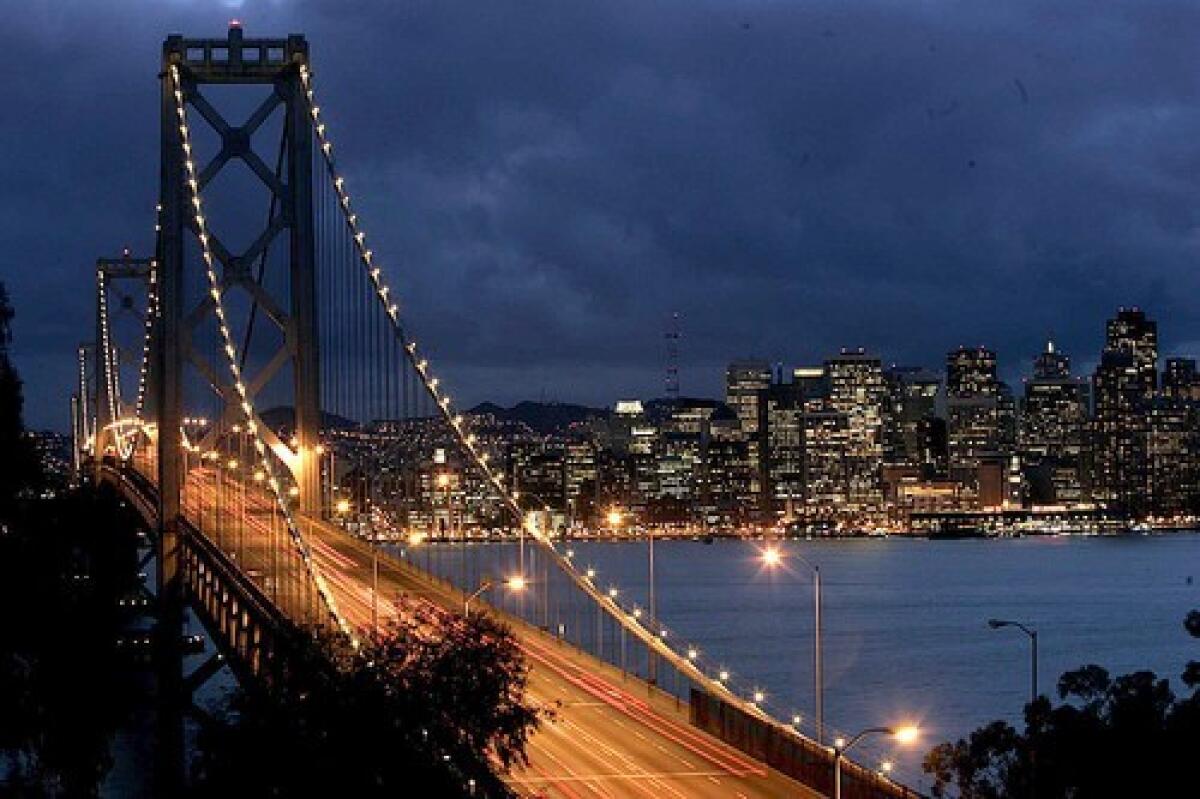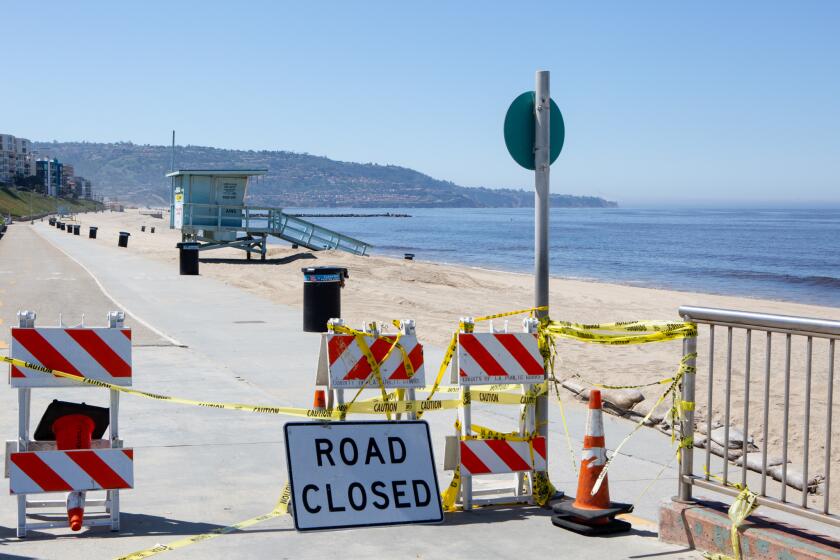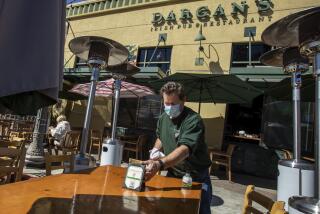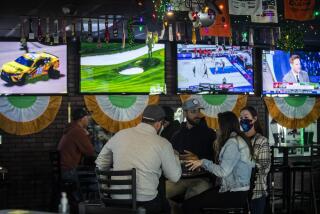Bay Area will allow some businesses to reopen, construction to resume

- Share via
SAN FRANCISCO — Six San Francisco Bay Area counties will allow all construction projects, real estate transactions and certain outdoor businesses to resume operations with certain conditions on Monday, while also largely retaining other stay-at-home restrictions through the month of May intended to curb the spread of the coronavirus.
The businesses that will be allowed to resume include outdoor wholesale and retail nurseries, garden centers, landscapers, gardeners and other businesses that primarily provide outdoor services. Certain outdoor recreational facilities previously ordered closed, including skate parks, can reopen if they do not involve shared equipment or physical contact.
The order will also allow flea markets and carwashes to reopen, San Francisco Mayor London Breed said.
Officials said outdoor businesses, “by virtue of their operation outdoors, carry a lower risk of transmission than most indoor businesses.” These businesses allowed to resume operations generally involve only brief and limited person-to-person interactions, authorities said, and make up only a relatively small proportion of business activity in the region.
“Outdoor businesses must conduct all business and transactions involving members of the public outdoors,” the order said.
Outdoor businesses must comply with the same social distancing protocols in effect for essential businesses like grocery stores, which include requirements like limiting the number of people within the facility to ensure people can easily maintain a six-foot distance from other people at all times, except as required to complete an essential business activity; requiring face coverings to be worn by anyone entering the business; and offering hand sanitizer.
Real estate transactions can resume, but open houses are still banned. The order allows for a maximum of two visitors, residing in the same household, to view a home, and only one individual to show the residence. Residents of the home being sold cannot be inside when it is being shown.
“These orders are generally consistent with the state’s shelter-in-place order. On any issue where the local and state orders may differ, the stricter order applies,” said a statement sent on behalf of Alameda, Contra Costa, Marin, San Francisco, San Mateo and Santa Clara counties, where 6.6 million people live. The same order was also issued in the city of Berkeley, which has a health department separate from Alameda County.
“A pandemic of this scale is unprecedented,” Dr. Sara Cody, Santa Clara County health officer, said in a statement. “We are progressing steadily as a region, but we must reduce restrictions on activity gradually or we will put the lives of many community members at risk.”
Six San Francisco Bay Area counties issued an extension of a stay-at-home order through May 31, 2020.
At a news conference, Cody said in other regions of the world, many areas have suffered a sharp resurgence in coronavirus cases when shelter-in-place orders were lifted too soon.
“If we move too fast to ease restrictions, the potential for exponential spread could have grave impacts to the health and wellness of our residents as well as to our economy,” Cody said. “And of course, the vaccine is still a long way off, and virtually our entire population is still at risk.”
Restaurants will continue to only be allowed to offer food for sale for takeout, delivery or drive-through service.
The new order also mandates people to continue sheltering at their place of residence with certain exceptions, such as to buy food, go to the doctor’s office and for other essential activities, business, government functions or to perform minimum basic operations for closed businesses.
The San Francisco Bay Area has seen consecutive weekly declines in the number of new coronavirus cases. Southern California has seen the pace increase.
All gatherings outside of a single household are still banned, with only limited exceptions. Outdoor recreation facilities that are outside of residences with high-touch equipment or that encourage groups are still off limits. Such places include playgrounds, outdoor gym equipment, climbing walls, picnic areas, dog parks, pools, spas and barbecue areas.
Skate parks and athletic fields can be allowed to reopen but must comply with social distancing and health and safety protocols to reduce the risk of overcrowding and disease transmission.
Some counties offered conflicting information on what kind of athletic facilities would be open. Dr. Susan Philip, San Francisco’s deputy health officer, said tennis courts and basketball courts will not be reopening because players share balls. “We still can’t share equipment,” Philip said.
But the health officer for Contra Costa County, Dr. Chris Farnitano, said on KGO-TV that tennis courts would be allowed to reopen.
The state of golf courses was also unclear. The San Francisco mayor said golfing can resume. But at a separate news conference, the county counsel for Santa Clara County, James Williams, said while the new Bay Area order would allow golf courses to reopen, the state has indicated golf courses are not allowed to operate.
However, Riverside County reopened its golf courses on April 20, but limited play to foursomes, required players to be separated by six feet, banned caddies and required players to wear face coverings. Napa County also allowed the use of golf courses in an order issued April 22.
Some areas started reopening up parks and trails. San Mateo County said it will reopen 13 of its 23 parks Monday. “Visitors will be required to hike single file on narrow trails, keep six feet apart from others, not congregate with people who aren’t from their household, and carry face coverings,” the county said. Some parking lots for parks will be opened; others will remain shut.
The rules involving child-care facilities remain the same: The order allows child-care businesses and summer camps to supervise children to enable the functioning of essential businesses, government agencies, outdoor businesses and workers conducting minimum basic operations of closed businesses.
Funerals are still limited to a maximum of 10 people.
The six counties that issued the new order, effective Monday, were the same original six counties that implemented the nation’s first shelter-in-place order on March 16, requiring residents stay at home as much as possible to slow the spread of the coronavirus.
Eleven other California counties, in the northern Bay Area, Sacramento area, North Coast and Central Coast, followed suit before Gov. Gavin Newsom issued a statewide stay-at-home order on March 19.
The statewide order never halted construction, but the Bay Area’s order for the six counties did. The original order dated March 16 allowed housing construction to continue. Then, on March 31, a new order halted almost all construction, exempting only healthcare projects related to addressing the pandemic; housing and mixed-use projects with at least 10% affordable housing, projects that provide services to vulnerable populations, and projects required to maintain safety, sanitation, and habitability of residences and commercial buildings.
Meanwhile, Los Angeles has allowed all types of construction to proceed but added requirements for workers to practice social distancing, wear masks that cover their noses and mouths, and be checked for COVID-19 symptoms at job sites.
Officials said the following criteria will be used to measure progress in the region’s fight against COVID-19:
- Whether the total number of cases in the community is flat or decreasing;
- Whether the number of hospitalized patients with COVID-19 is flat or decreasing;
- Whether there is an adequate supply of personal protective equipment — such as masks, gowns and gloves — for all healthcare workers;
- Whether the need for testing is being met, especially for people in vulnerable populations or those in high-risk settings or occupations; and
- Whether there is a capacity to investigate all COVID-19 cases and trace all of their contacts, isolating those who test positive and quarantining the people who may have been exposed.
Newsom released a four-part plan that he said could have some businesses running in weeks and some schools reopened by the summer.
But the outline, officials acknowledge, still has many uncertainties. It is contingent on improvement in the fight against the coronavirus outbreak and on increased testing to assess how the illness is spreading.
Under Newsom’s plan, some retail businesses, manufacturing, schools and open spaces could reopen first, with strict social-distancing rules. Down the line, some entertainment venues and religious institutions could reopen. Live sports, concerts and other crowded events would be the last to resume.
During a news conference with other city officials, San Francisco’s mayor also reported that homeless people from other counties have moved to San Francisco to ask to be placed in city-leased hotels. She stressed that the hotel rooms were for homeless individuals who lived in the city before the health crisis.
“Only people who are currently in our homeless system of care may qualify” for hotel rooms and other accommodations, Breed said.
She said 120 RVs and trailers have been placed at Pier 94 for homeless residents of the Bayview-Hunters Point community. Priority will be given to homeless people 60 or older and to those with underlying health conditions. The trailers and RV’s will open for what city officials call “guests” next week, and support staff and meals will be provided, city officials said.
Abigail Stewart-Kahn, director of San Francisco’s homeless services, asked homeless residents from other counties to return to there. “We need you to return to your home communities and get the resources there,” she said.
More to Read
Sign up for Essential California
The most important California stories and recommendations in your inbox every morning.
You may occasionally receive promotional content from the Los Angeles Times.













